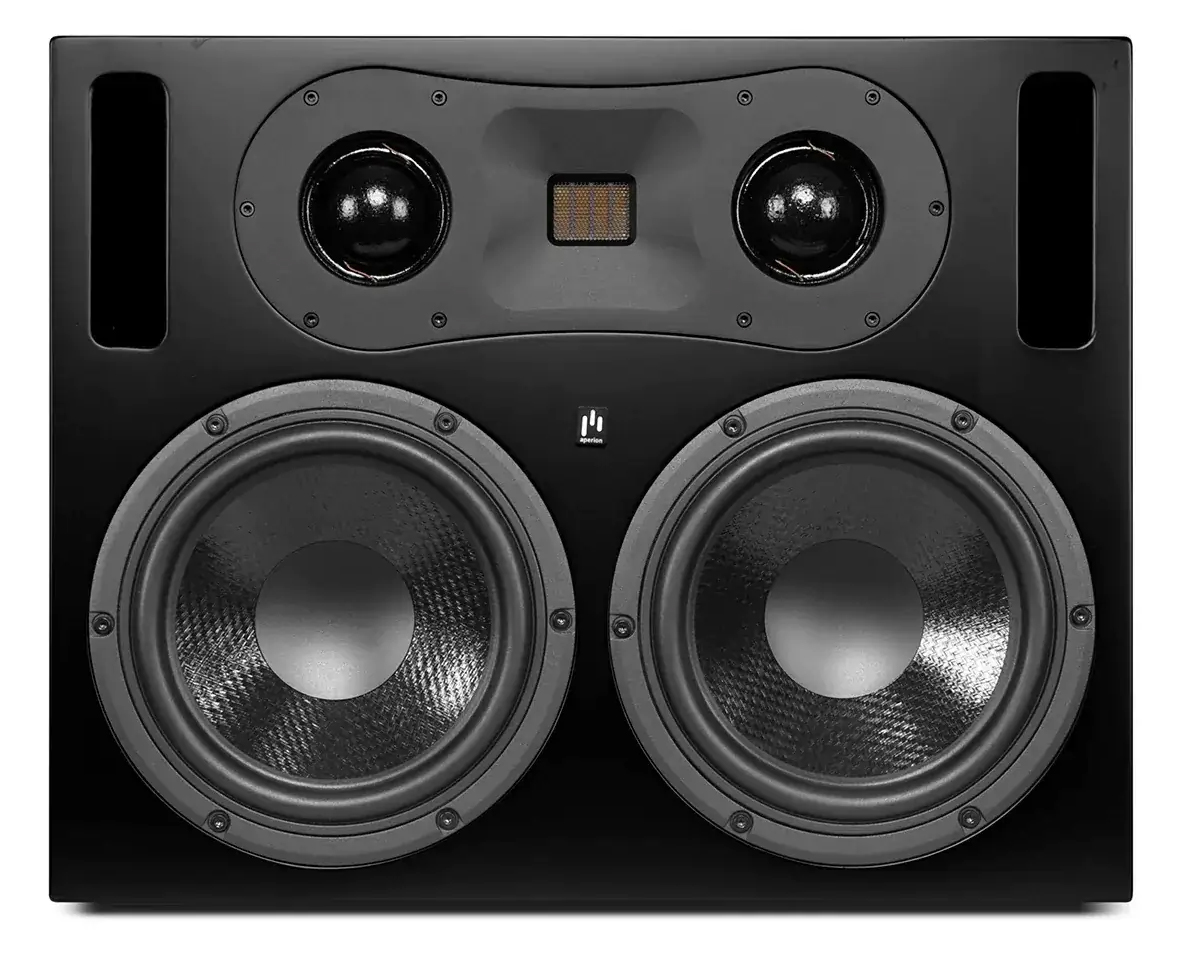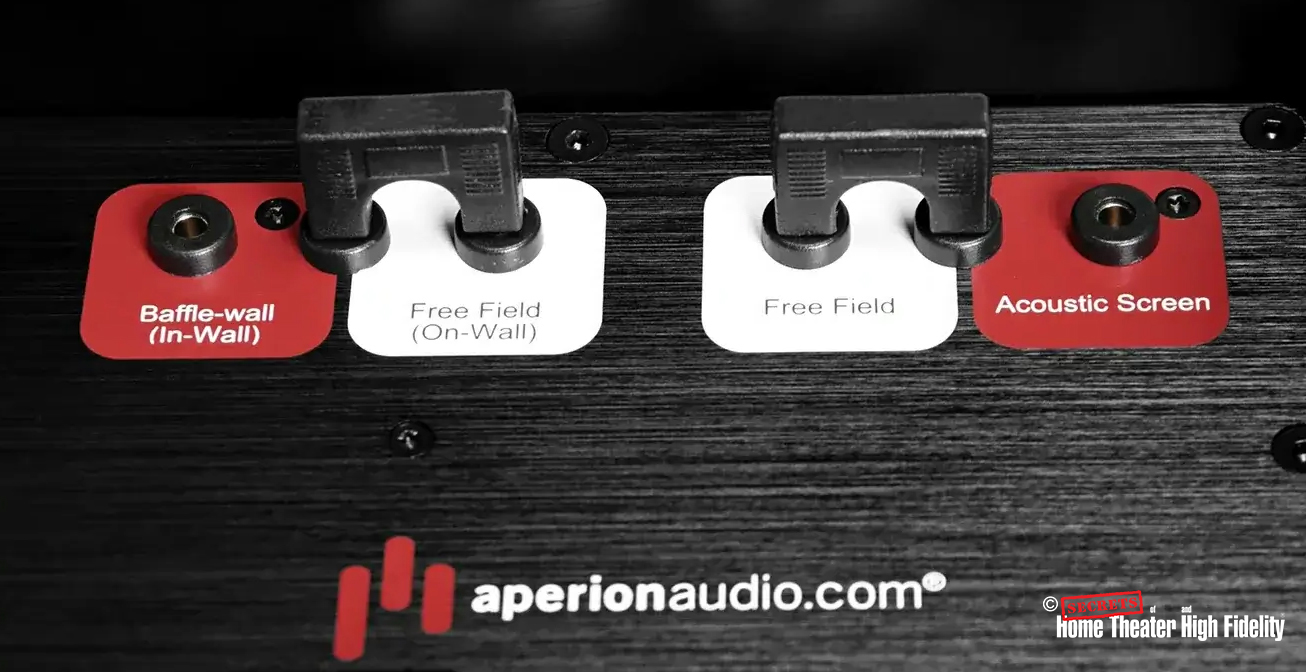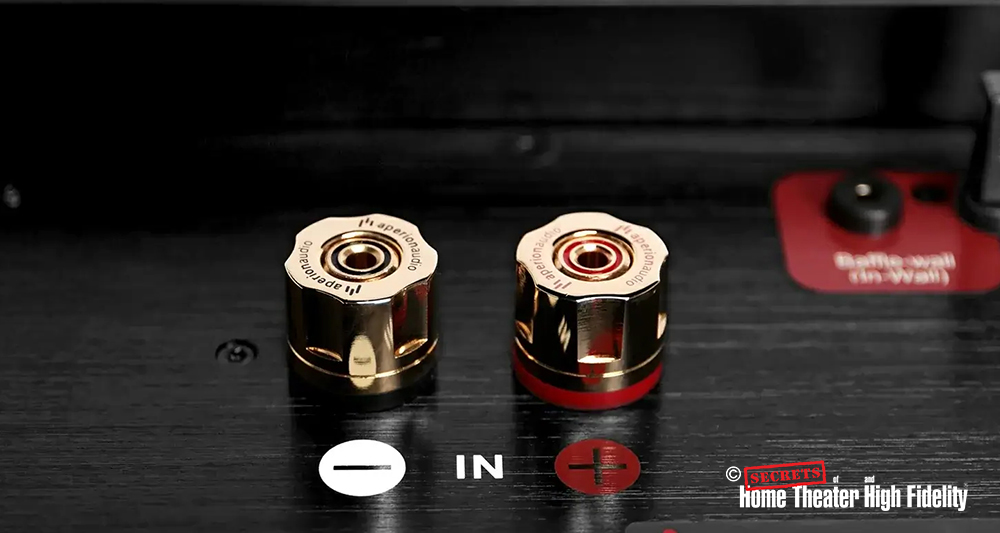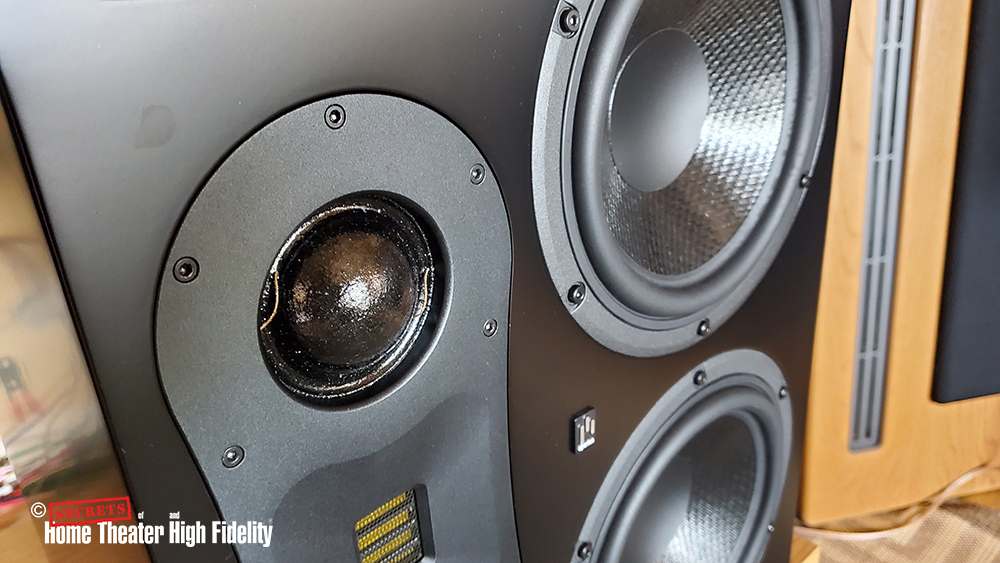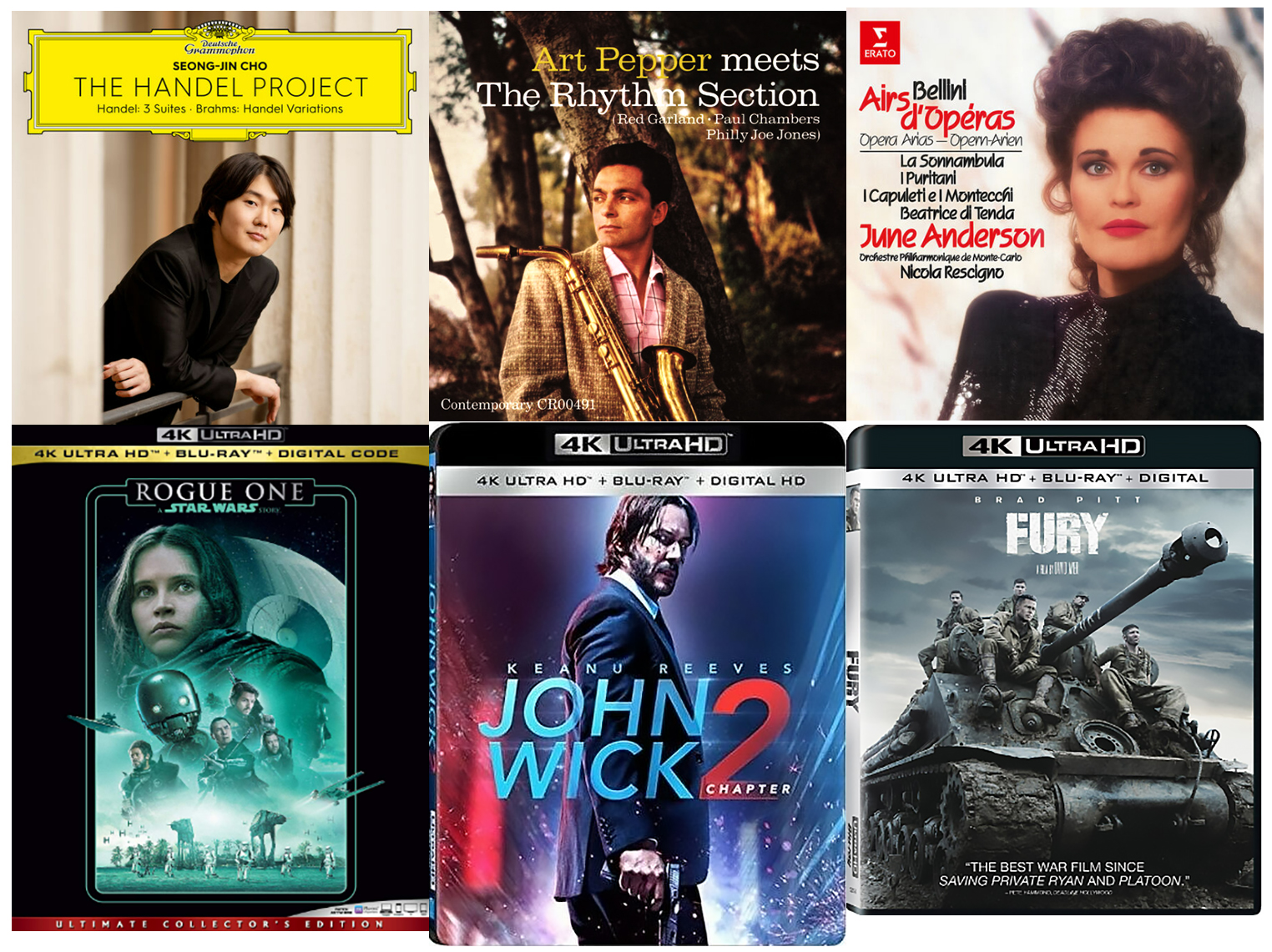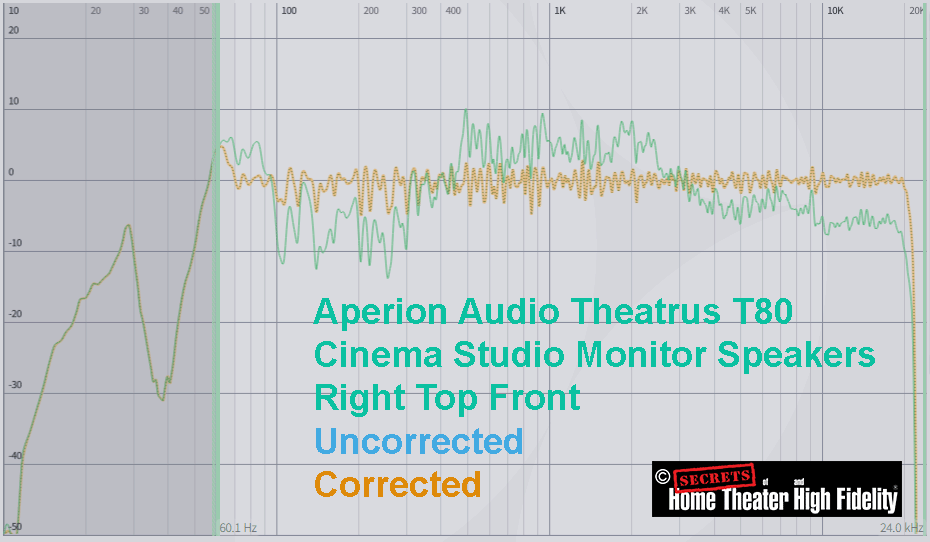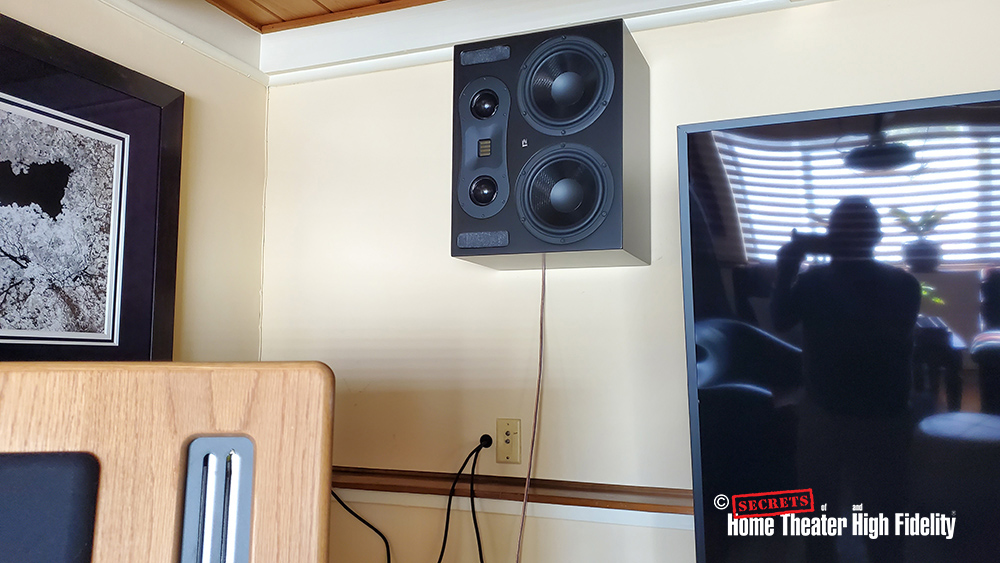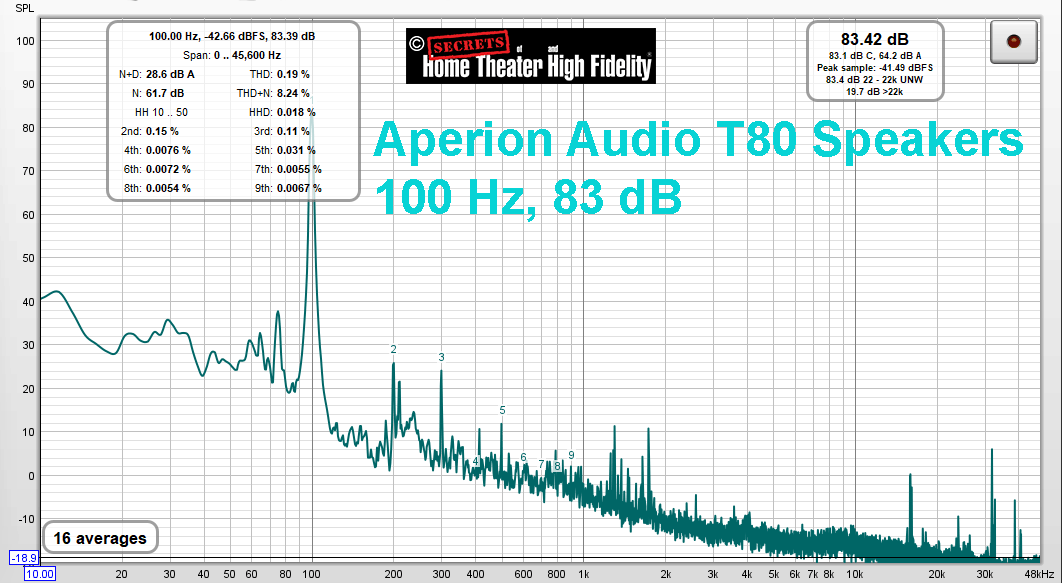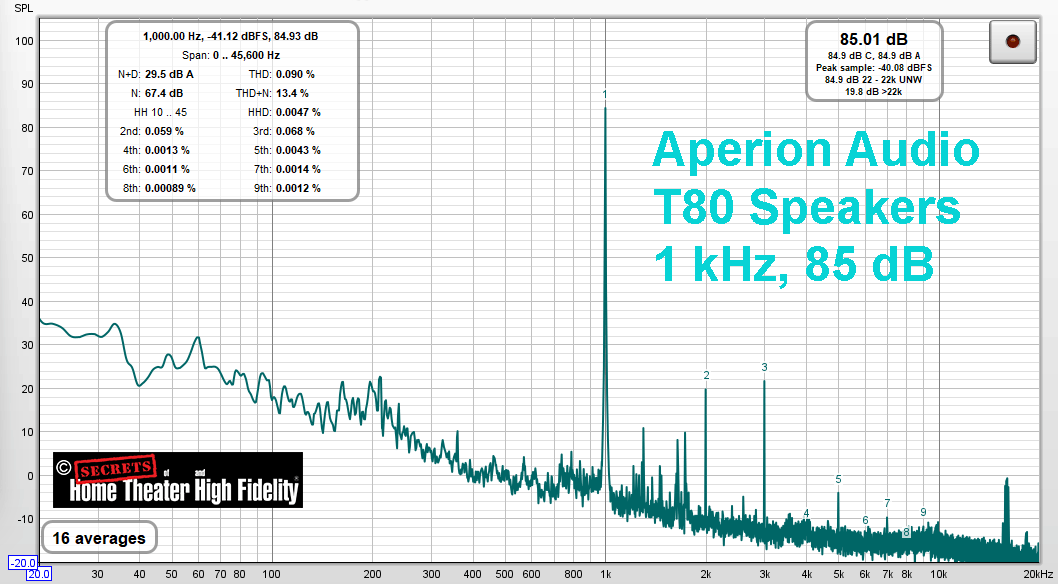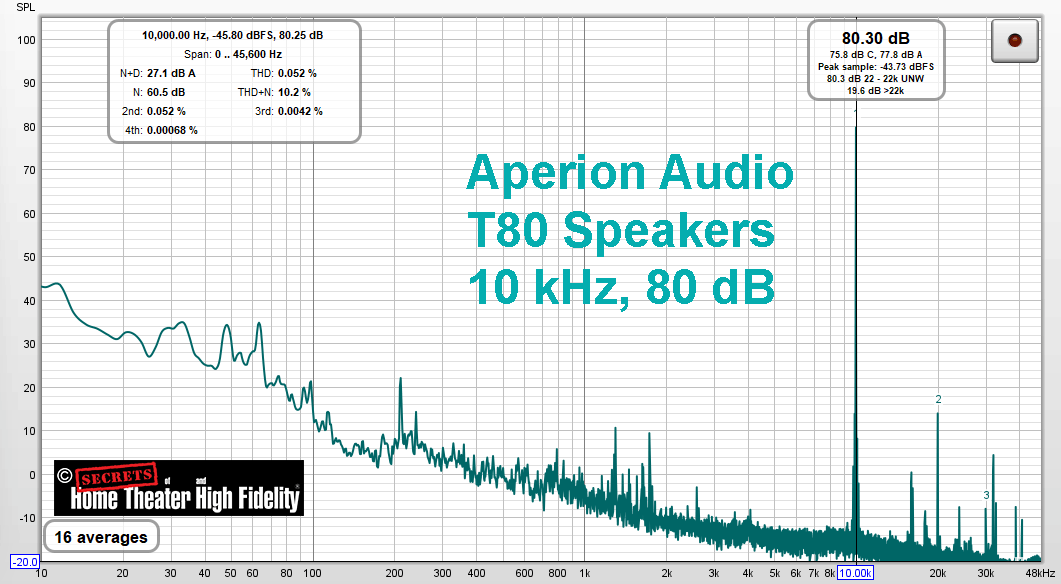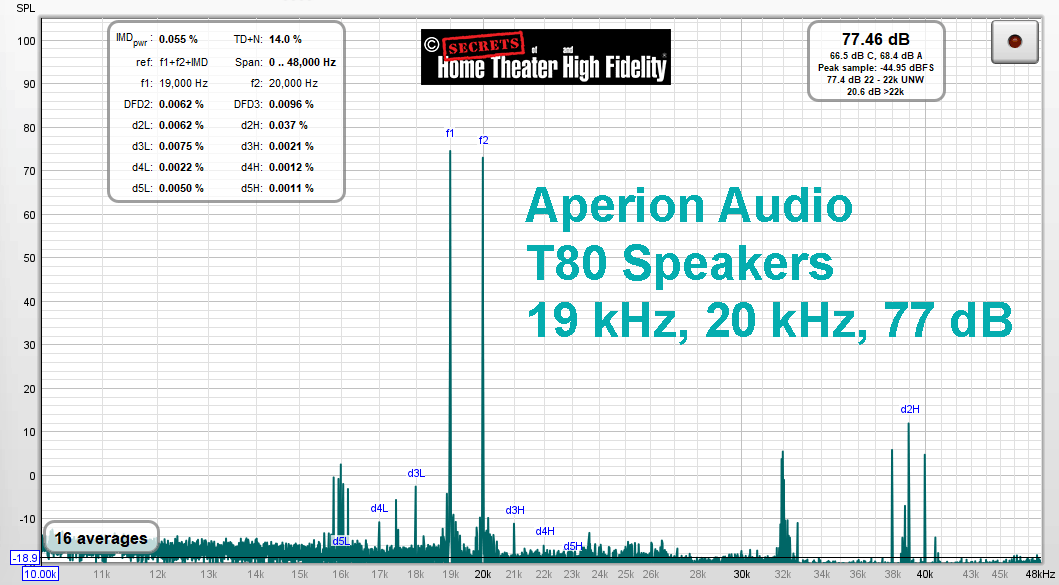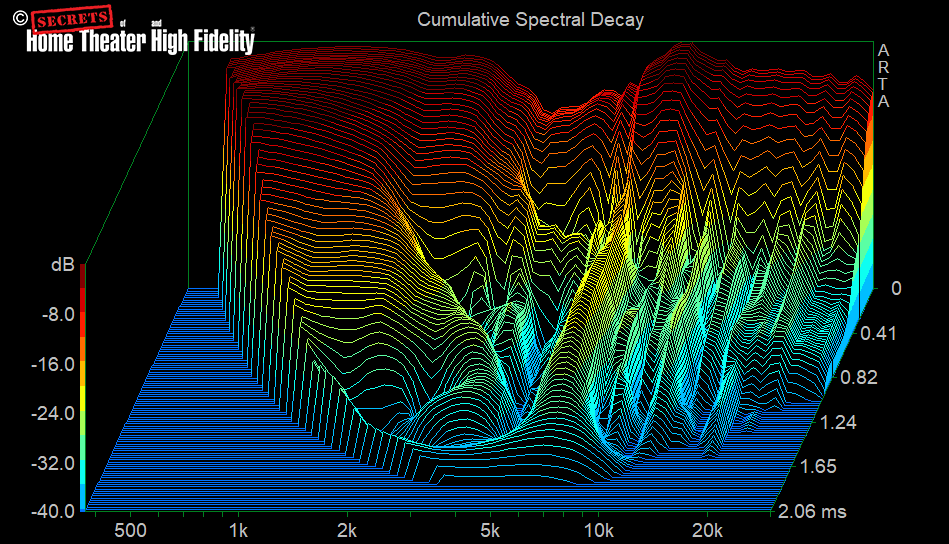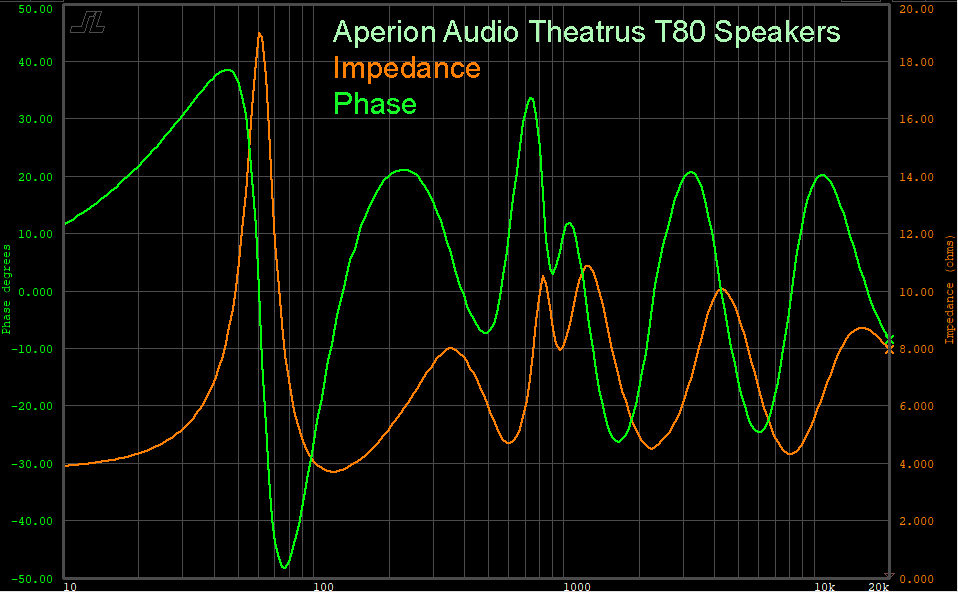Aperion Audio Theatrus T80 Cinema Studio Monitor Speakers Highlights
- Dual midrange and woofer drivers
- Ribbon tweeter
- Massive build with the money spent on the sound, not the appearance
- Jumpers for adjusting frequency response of lows and highs for in-wall vs. on-wall mounting and behind an acoustically transparent projection screen
Aperion Audio has been around for a long time, which is testimony to their success over the years. They know what their customers want.
I started a video series, “Stereo Audio & Home Theater 101+” where I described components that consumers and afficionados to the audio and video world might find useful in setting up a home theater. In “Video 3, The Speakers” I reviewed three models of bookshelf speakers which I recommended.
Since then, I have found other models which I also feel would be good choices. One of these is Aperion Audio’s Theatrus T80 Cinema Studio Monitor Speakers. For comparison, I recently reviewed the Aperion Verus III Concert V8B Bookshelf Speakers.
DESIGN:
Three-way studio monitor, dual ported on front
DRIVERS:
One 1.5” AMT (Air Motion Transfer) ribbon tweeter
Two 2” fabric-dome midrange drivers
Two 8” “German Curv Cone” woofers
CROSSOVER FREQUENCIES:
Tweeter-to-Midrange: 5 kHz
Midrange-to-Woofer: 800 Hz
BINDING POSTS:
Large and heavy
FREQUENCY RESPONSE:
30 Hz – 35 kHz
NOMINAL IMPEDANCE:
4 Ohms
SENSITIVITY:
94 dB @ 1 Watt, 1 Meter
FINISH:
Flat black
DIMENSIONS:
15.75” W x 19.7” H x 11.8” D
WEIGHT:
50 pounds/each
MSRP:
$1,349/ea. USD
Website:
Company:
SECRETS Tags:
aperion audio, aperion audio speakers, aperion audio speakers reviews, aperion audio speakers reviews 2023, speakers, speakers reviews, speakers reviews 2023
The Aperion Audio Theatrus T80 Cinema Studio Monitor Speakers are a 3-way design, meaning tweeter, midrange, and woofer. This type of speaker is used in professional music recording studios. It can be mounted vertically as shown in the first photo below, or horizontally as shown in the second photo below. If mounting them on a wall, mounting plates are supplied for each speaker. They are not classified as “Bookshelf” or “Floor-standing”, since they are usually on-wall or in-wall.
I used one of the T80’s as a center channel speaker with a horizontal alignment, shown in the photo above, and it worked beautifully. Then, I mounted both of them on the wall behind my 75” Sony 4K TV, placed vertically. Photos of this are shown later in the review.
The rear panel has a set of jumpers for several mountings. The one on the left is for setting the low frequency response curve for the speaker mounted either on-wall or in-wall, and the one on the right sets the high frequency response curve for when the speaker is mounted behind an acoustically transparent projection screen or not.
There is one set of speaker binding posts, and they are really heavy-duty posts. Once these speakers are on or in the wall, it would be difficult to work with the jumpers or binding posts, so it is important to set everything before hand, including the use of bare wire or speaker lugs on the ends of the cables, tightened down securely. If one of these speakers is on a stand for use with the center channel, which I did (and really liked the results), banana plugs are OK.
Speaker drivers include a 1.5” ribbon tweeter, two 2” fabric-domed midrange, and two 8” ”German Curv Cone” woofers. The glossy reflections on the surface of the fabric dome of the midrange drivers is due to the “doping” which stiffens the domes.
There are two ports on the front, one above the upper midrange driver, and one below the lower midrange driver. The ports are fitted with foam plugs as default. I tested the speakers with the foam plugs left in.
Notice that the tweeter is vertically aligned in between the two midrange drivers. For the speakers situated vertically, this minimizes phase differences between the tweeter and midrange sound as the listener moves off to one side of the center listening position. The woofers are to the side of the tweeter and midrange drivers because the phase issue of listening off-axis is not a problem there. Since there are mounting holes on the rear of the T80’s for mounting them vertically or horizontally, you should just listen to them in both positions, and select the mounting arrangement that you prefer.
I listened to the Aperion Theatrus T80’s using an OPPO UDP-205 Universal Player, Pass Labs XP-20 Stereo Preamplifier, Pass Labs X600.8 Monoblock Power Amplifiers, and Emotiva RMC-IL 9.1.6 Surround Sound Processor. Other amplifiers powered the additional channels.
I have a Pass Labs XP-20 preamplifier wired in with my OPPO UDP-205 player and Emotiva RMC-1L processor such that it is in series with the front left/right output from the processor to the Pass Labs X600.8 Power Amplifiers, but also direct from the UDP-205 to the XP-20 so that I can bypass the processor when listening to stereo music from the player. The signal also goes to the processor when I am doing this which allows the subwoofers to be active. In this case, I just do not turn on the other power amplifiers.
Some studio monitor speakers have built-in power amplifiers, but they then need a 120 Volt AC supply cable to the speakers, along with RCA signal cables. I prefer to supply my own power amplifiers, which work with the T80’s since they do not have built-in power amplifiers.
First, I listened to a T80 as the center channel in my home theater. For the price, the T80 is one of the best speakers I have ever heard in a center channel. Clarity is very important when voices in movies are concerned, and studio monitor speakers are designed for clarity and detail.


Using Dirac Live with my RMC-1L processor, the Aperion T80’s were easy to flatten, compared to some speakers whose response is so far off, they cannot be EQ’d to flat. The figures below show the two T80s’ response uncorrected and corrected via Dirac Live® software in the Emotiva processor, with the two T80’s mounted on the wall off to the sides of the Sony 4K TV. I used a 60 Hz crossover frequency from the T80’s to my subwoofers. I recommend this crossover frequency for all large bookshelf speakers and studio monitor speakers, and a 70 Hz crossover for smaller ones. In the figures, you can see a darker shaded area below 60 Hz. This is called a “curtain”, and this region is not corrected by the Dirac software for the two channels occupied by the T80’s. These low-frequency regions are corrected by Dirac in the subwoofer channels.
If the increase in high frequency response that Dirac does to flatten the response causes the sound to be slightly harsh, as it can do with some speakers and power amplifiers, you simply adjust the curtain on the right side to a lower frequency, such as 3 kHz That way, the frequencies above 3 kHz will not be boosted by Dirac. The problem occurs because room correction for a speaker is based on the average of several measurements at different positions, with most of them being made off-axis of the speaker. Going off-axis results in attenuation of high frequencies. So, if you let the software flatten the response, and you sit on-axis, the boost in high frequencies will be above the flat response line which can make the sound “hot” (harsh).
The upside of room correction is that if you have a variety of different speakers, the corrected response will give you a similar tonal character in all the speakers which will be great when a sound effect pans from one speaker to several others, such as a jet moving from the rear right surround to the overhead height speaker to the front left speaker as can be done with Dolby Atmos. If listening to music coded in Dolby Atmos, the instruments in the various channels will also have a balanced tonality. The 2L 2023 album Cantus Yggdrasil – Music in 9.1.4 Dolby Atmos – 2L, Norway, 2023, cover art shown three photos above, is a good example of how room corrected frequency response for surround sound speakers keeps voices in the various speakers to have the same tonal character.
I recommend the T80’s as front main left/right speakers, as well as any of the surround positions. They could be stand-mounted in all these positions even though they are designed to be on-wall or in-wall.
Here are some photos of the T80’s mounted next to my TV on the wall. I assigned them as as Top Front (front height channels). I have rear height speakers above the seats. The T80’s were positioned vertically rather than horizontally, with tweeters and midrange drivers on the outside edge rather than inner. The TV and speakers look somewhat smaller than they actually are, due to the extreme wide-angle lens that I used to photograph them in the first photo. I left the grilles off for the photos (actually they look rather cool that way, so I might leave them as such).
Since there is only a flat paint finish on the T80’s, you could paint them the same as the wall color or some other color that complements the wall color. The third photo shows one of the previously reviewed Aperion Verus III speakers configured for the Front Wide channel. Behind on the right are four Pass Labs X600.8 monoblocks for the front main left and right, and the rear surround left and right channels.
First, the single-frequency distortion tests. The T80 was situated on the small table in the photos above, with the table moved to a different part of the room, a calibrated microphone arranged 1 meter away, on-axis with the center of the speaker. The speaker was vertically positioned on the table.
The woofer.
60 Hz. THD is 0.063%, and although the 3rd and 4th harmonics are larger than the 2nd by just a bit, none of the harmonics are large (the harmonic orders are shown as numbers immediately above the peaks). You can click on the figures to see them full size so you can read the distortion numbers in the top left corner.
100 Hz. Distortion is now a bit higher, at 0.19%, but this is still a good measurement, and now the 2nd harmonic is the largest one.
200 Hz. Distortion is 0.16%, and the 3rd harmonic is now the largest.
1 kHz. Again, the 3rd harmonic is larger than the 2nd harmonic, but only slightly, with overall distortion at 0.09%, which is very good. This is from the midrange driver.
And, at 10 kHz, which tests the tweeter. The 2nd-ordered harmonic is the largest. The overall THD is 0.52%.
19 kHz, 20 kHz. This is a test that is not often used, but I think it is important, just as it is with testing preamplifiers and power amplifiers. The results show modest distortion, with IMD at 0.055%. It is something I have just recently added, so we will see how it pans out with other speakers later on.
The above distortion measurements are lower than the same tests for the Aperion Audio Verus III Concert V8B Speakers which I reviewed recently, and which are bookshelf (stand-mounted) speakers. This shows one of the areas where monitor speakers shine, namely, low distortion. That is very important when mixing music tracks in a recording studio. They also make one heck of a home theater speaker.
Here is the step response, which shows that the drivers in the T80 speakers are all in-phase with each other.
The figure below shows the Impulse Response-derived frequency response, along with harmonic distortion spread for all the frequencies. The overall response stays within a 10 dB window out to 30 kHz, except for frequencies below 50 Hz. This is why I used a 60 Hz crossover to the subwoofer in some of my listening tests. This response is somewhat flatter than the Aperion Verus III Concert V8B speakers, reviewed previously. Again, studio monitors are designed specifically to have low distortion and a flat frequency response. Notice how harmonic distortion stays below 1% down to about 45 Hz. The dip at 160 Hz is a standing wave suck-out caused by the room, not the speaker.
If you place the T80’s behind an acoustically transparent projection screen, you should set the high frequency jumper on the rear of the speakers to the Acoustic Screen position, which will boost the high frequency response somewhat to take into account the partial high frequency absorption that the screen has.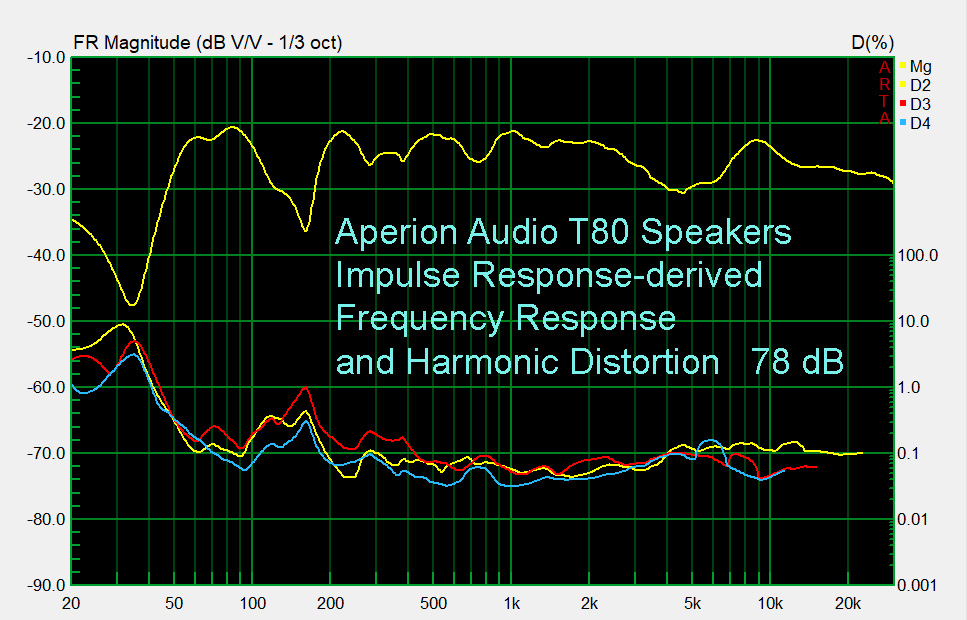 The Cumulative Spectral Display (CSD) is shown below. Enclosure resonance is reasonably controlled, and there are some resonances in the drivers. There are more resonances in large speakers with drivers additional to a tweeter and woofer, which is the case for the T80’s. Resonance is gone (-40 dB) by 2 ms (milliseconds).
The Cumulative Spectral Display (CSD) is shown below. Enclosure resonance is reasonably controlled, and there are some resonances in the drivers. There are more resonances in large speakers with drivers additional to a tweeter and woofer, which is the case for the T80’s. Resonance is gone (-40 dB) by 2 ms (milliseconds).
Here is the Impedance/Phase plot (below). Impedance has a low of 3.8 Ohms at 120 Hz and a high of 17.5 Ohms at 60 Hz. The phase has a low of -48.50 at 78 Hz and a high of +380 at 45 Hz.
The Aperion Audio Theatrus T80 Cinema Studio Monitor Speakers perform very, very well, and can be used for any of the home theater channels. I was surprised at how good a center-channel speaker one of them made. If you like low distortion, the T80’s should be seriously considered. I would be fine with these in all the channels in my home theater. Just remember to get some kick-butt subwoofers (more than one – I have two and am getting ready to purchase a third).
- Smooth sound
- Low distortion
- Flat response
- Excellent value for the dollar
- Larger mounting plates with a vertical upside-down pyramid-shaped plate on the speaker plate that slides downward into the wall plate, to make mounting easier



